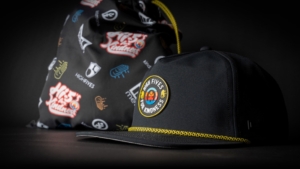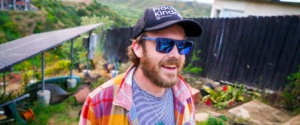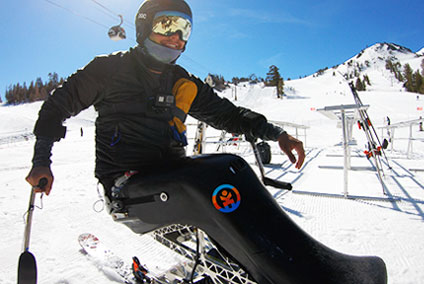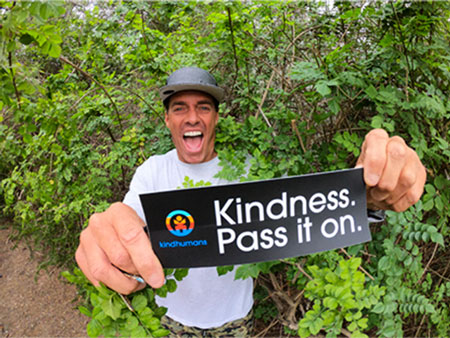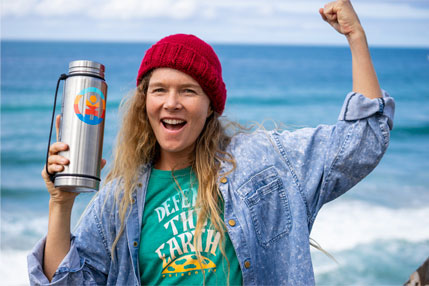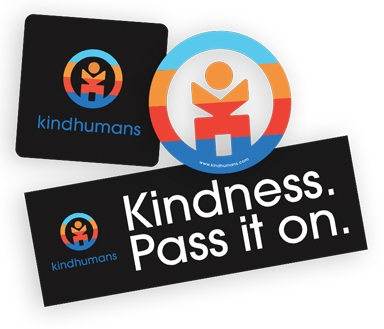
How a Water Box Uplifts a Community
CauseHow a Water Box Uplifts a Community
Last month, we shared our latest collaboration with Jaden Smith’s 501CTHREE to install a Water Box in Skid Row, Los Angeles, where nearly 5,000 people don’t have access to clean, cold water.
The Water Box, created by 501CTHREE, is a water dispenser that can be connected to existing pipes and sends water through two carbon filters, a UV treatment and a cooling system, eliminating contaminants like bacteria, pathogens and even lead. It has a dispenser for filling water bottles and a hose to quickly fill jugs.
Designed to address water crises in the U.S. and abroad, the Water Box can run off solar panels, sits on wheels for easy transport, and is designed to be so simple to set up that one can download instructions off the internet and assemble it themselves.
Watching the Skid Row Water Box begin its journey to supply drinking water for those who so badly need it inspired us to check in on the very first Water Box that Kindhumans supported, at the Sylvester Broome Empowerment Village (SBEV) in Flint, Michigan.
When we teamed up with 501CTHREE to donate this Water Box, Flint’s water supply was in a crisis state. In 2013, the city of Flint was facing a huge budget deficit, and the Michigan governor’s office mandated that Flint cut costs by pumping water from the Flint River instead of from Detroit. The polluted river water was corrosive, and as it passed through Flint’s aging pipe system, lead seeped from the pipes into the water.
Lead is extremely dangerous for children, and can cause developmental and physical impairment, including compromised IQ, cardiovascular issues, and behavioral challenges. When consumed by pregnant women, lead can damage fetuses, and in adults, it’s been linked to high blood pressure, heart and kidney disease, and infertility.
To make things worse, since Flint River water wasn’t being treated sufficiently, it was also rife with bacteria. This is thought to be the reason for an uptick in Legionnaires’ Disease around the same time, which killed at least 12 Flint residents.
It took months for the government to acknowledge the presence of bacteria in Flint’s water—even as residents complained of sludgy, brown water coming out of their taps—and almost a year went by before the EPA concluded that Flint’s water also contained dangerous amounts of lead.
Right before Flint discovered its water crisis, Dr. Jawad Shah, a local neurosurgeon, had bought a shuttered school building in North Flint to found a youth center called the Sylvester Broome Empowerment Village. Unbeknownst to him, he would almost immediately need to pivot SBEV into a crisis center, where residents could come for free lead testing, dermatology screenings to check for lead-induced rashes, and the distribution of bottled water needed for drinking, cooking, and even bathing.
Maryum Rasool, executive director of SBEV, remembers this time all too well. “We were giving out two to three pallets of water every couple of days,” she says. “Just hundreds of bottles.” Cars would wrap around the block waiting hours for water, while other people arrived on foot and by bike, no matter the weather, to get as many water bottles as they could carry.
At the same time that it served this desperate need, SBEV still wanted to fulfill its dream of becoming a development center for Flint youth. North Flint was known as a high-crime area with little opportunity for its residents. Flint was the original home of General Motors, and Buick had a factory in North Flint for 95 years. When the factory closed in 1999, unemployment skyrocketed and the area spiraled into an economic depression from which it still has not recovered.
SBEV knew that Flint youth needed support. To better target their mission, the staff rented an ice cream truck and drove around Flint, offering free ice cream in exchange for filling out a survey about what type of community programs residents wanted to see at SBEV.
“The three things they really wanted were athletics, academics and access to arts,” says Rasool. SBEV coined this the “Triple-A Effect,” and partnered with local organizations to create after-school and summer youth programs that promoted acceleration in these areas.
SBEV students choose two “tracks” to focus on from 20 different programs in music, art, sports, STEM and more. They select a “major” and a “minor,” at least one of which must be from an academic track. Academics are a key focus for SBEV in light of education inequities in Flint, where the third grade literacy rate dropped to 10.7% after the water crisis.
The tracks at SBEV give students incredible enrichment opportunities that most can’t enjoy at their schools. The music program, for instance, includes advanced classes like DJing and studio recording. Robotics is offered as an academic track, along with journalism. But for some families, the most valuable part of the SBEV programs is the consistent after-school meal and a safe place for their kids to spend time without falling into trouble.
When SBEV began, it supported 30 students. SBEV now enrolls 270-350 students at a time (outside COVID; due to COVID enrollment is upwards of 75 daily), currently has over 1,0000 students enrolled in the program, and has touched 7,000 families through community programs in one year. But seven years after the Flint water crisis began, SBEV is still acting as a water distribution center, too.
“By 2018, some people still couldn’t use the water coming through our pipes, but we were required to pay our water bill,” says Rasool. “We couldn’t drink the water, access to and delivery of water bottles was inconsistent, and it was really hard to use bottles for everything, not to mention bad for the environment.” So when volunteers from nearby Kettering University asked SBEV what it needed most, the answer was water—for their students and the community at large.
Volunteers from nearby Kettering University linked SBEV to 501CTHREE, which in turn connected us, Kindhumans, to the effort. 501CTHREE had donated the first-ever Water Box to a church in Flint a few months prior, and word had spread among the community that there was finally a better way to get water.
“The church did a really good job in creating trust around the Water Box,” says Rasool. “There are a lot of trust issues here still, but the church addressed these issues and when we received our Water Box, people already knew about it, and were excited to line up.”

Kindhumans and 501CTHREE donated SBEV’s Water Box in 2019. For the students, the Water Box provided clean drinking water for athletics and meal time, and an opportunity to start a conversation about reducing single-use plastic. For families, it offered a much more consistent and feasible alternative than stocking up on small water bottles. While most of the pipes in Flint have been replaced, many residents are reluctant to believe the government’s claim that the water is truly safe. “I understand the mistrust, especially from those who had lost a loved one,” says Rasool. “And some people’s pipes are still not fixed. You try buying water in addition to paying your water bill.”
Just a few months after the Water Box was installed, COVID-19 shutdowns created a food crisis across the country as well. SBEV began pairing water distribution with a weekly food distribution of vegetables and fruit. Just like in the peak of the water crisis, cars and pedestrians began lining up hours ahead of time to receive a fruit and veggie box, and to fill their jugs of water. Some families fill extra jugs for elderly neighbors who can’t leave their homes.
Youth are slowly beginning to return to in-person programs at SBEV. They range in age from five to 17. All of them were either born into, or spent their formative years, mired in crises. Since 2014, they’ve grappled with water contamination that threatened their developmental and physical health, followed by an educational shortfall that left them struggling to catch up with their peers, and now a global pandemic has cut off their access to school and left many families in desperate situations. The programs at SBEV give students consistency, support, and opportunity. In donating this Water Box, we hope that providing a basic need like water gives these students and families one less thing to worry about.
“The best ending will be that we all have clean water in our homes,” Rasool says, “but while we don’t, it’s extending a lifeline to those who need it most.”
To support the Water Box program, choose “Humanitarian” as your 3% giveback program at checkout in the Kindhumans store. A portion of your purchase will support donating more Water Boxes and refillable jugs for communities that lack access to this basic human right.



